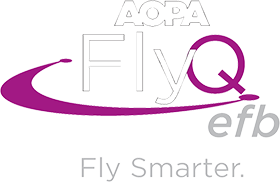

AOPA EFB FlyQ makes it very easy to create an ideal, wind-optimized flight plan any way you prefer. Plans can be created whether you're connected to the Internet or not but some advanced features are only available when online. Flight Plans created when you're online are automatically available from any device running a FlyQ application such as FlyQ Pocket for the iPhone, FlyQ Pocket for Android, or, soon, FlyQ Flight Planner from your desktop PC or Mac.
FlyQ EFB just needs a few inputs to plan your flight.
From: Enter the airport ident (either with or without the 'K'), its name or even the city. Use the Recent button to select from a list of airports you've recently used. Generally FlyQ defaults to taking off from the home airport you've specified. Change your home airport by tapping the Settings button then tapping the Defaults button in the Flight Planning section.
To: Same as above but your landing airport.
Takeoff: Tell the system when you want to takeoff, in the current local time.
Type: FlyQ applies different rules for planning VFR and IFR flights so select the type of flight you expect. This is also used when filing the flight plan via DUAT.
Routing: FlyQ's autorouter can plan wind-optimized flights on airways or using GPS Direct. For airways, you can choose between Victor Airways (lower than 18,000 ft. MSL) or Jet Airways (FL180 or above). Be sure not to plan for Jet Airways if the selected aircraft cannot fly above FL180. Planning via GPS Direct tells FlyQ to create as direct as possible flight between the From and To airports but apply rules for terrain avoidance and wind-optimization. You can also use the Wind/Fuel Only method to simply plot a direct line between From and To and wind-optimize it. This differs from GPS Direct in that the GPS Direct method may also add some intermediary waypoints for long flights. Finally, if you simply want to calculate the time/distance between two points without any wind-optimization, select (None) as the routing method.
Optimize for best winds: Normally FlyQ will use the winds-aloft forecast for your flight time to plan the best altitude for the flight. Select Off to disable this feature.
By tapping the More button at the top of the screen, you can control additional routing parameters.
Pilot: FlyQ allows you to create as many different pilots associated with your account as you like. When FlyQ requests a DUAT weather briefing or files a flight plan, it uses the credentials associated with the selected pilot.
Aircraft: Many pilots fly more than one plane so FlyQ lets you create as many aircraft profiles as you like. In the Settings tab, tap the Aircraft button to add or edit aircraft profiles.
Route: Normally FlyQ calculates a flight plan based entirely on your takeoff and landing airports. Use this field to specify any intermediary waypoints, navaids, or airports by ident. Add multiple route entries by separating them with a space (e.g. LOFAL SEA PDX). Enter Victor or Jet airway idents (such as V495) and FlyQ will plan along the specified airway. Even add SIDs and STARs. Note: If you enter an airway, the router will ignore your Routing setting and just plan along the specified airway(s).
Number on Board: Unless otherwise stated, FlyQ will plan flights with just one person, the pilot, onboard. Enter a different value in this field. Change your default setting from one using the Defaults button within the Settings tab.
Max Altitude (MSL): Normally FlyQ uses wind-optimization to plan the fastest flight possible by potentially going up to the service ceiling of your aircraft. Use this field to enter a specific altitude (MSL) either higher or lower than the service ceiling.
Min Altitude (AGL): When using the GPS Direct routing method, FlyQ will plan to keep about 1,000 ft. above ground level (AGL) at all times except takeoff and landing. Use this setting to choose an AGL setting either higher or lower. Use the Defaults button within Settings to change your default AGL clearance.
Min Cruise (MSL): For some aircraft, typically jets or very high-performance pistons, it's economically impractical to fly below a certain altitude regardless of the effects of winds. If you fly such a plane, enter an appropriate value here or use the Defaults button in Settings to specify your preference.
Takeoff fuel: Unless otherwise stated here, FlyQ will assume your plane takes off with a full tank of fuel. Enter a higher or lower value as desired. Note that the units used here depend on whether your plane uses AvGas (100LL) or JetA. When using JetA, the fuel value should be entered as pounds (lbs), otherwise the system uses gallons.
Show altitude change points: FlyQ can show you a flight plan that includes points for when you reach the beginning of your cruise altitude (also known as TOC or Top Of Climb) and when you should begin your descent (TOD or Top of Descent). Normally this is suppressed but you can turn this feature on here.
When FlyQ says that it cannot compute the flight plan, it generally means that some of your input parameters conflict. For example, you can't plan a flight on Victor Airways through the Rocky Mountains with a Max Altitude of 7,000 ft. When you see this error message, please use the More button to set or review your inputs.
Aspen Avionics makes the Evolution glass panel system. They have a device called the Connected Panel that is essentially a WiFi base station in the aircraft that allows iPads to communicate with the onboard avionics such as a Garmin 430/530 via the Connected Panel. The 'Send to Aspen' button sends the current flight plan to the Connected Panel where a pilot can then choose to copy it to their 430/530.
